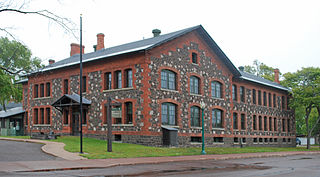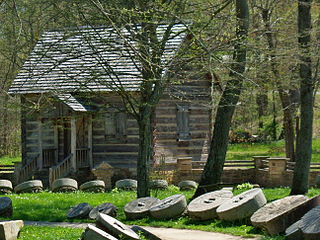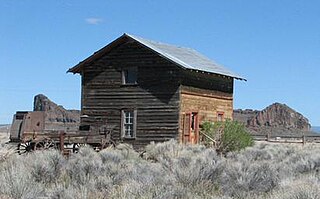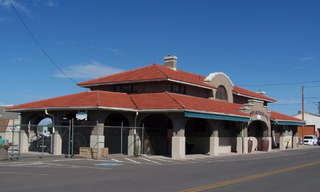
Elijah Clark State Park is a 447-acre (1.81 km2) Georgia state park located in Lincolnton, on the western shore of Lake Strom Thurmond. The park is named for Elijah Clarke, a frontiersman and war hero who led a force of pioneers in Georgia during the American Revolution. A reconstructed log cabin displays colonial life with furniture and tools dating back to 1780. The park is also the site of the graves of Clark and his wife, Hannah. The park's location on the lake makes it popular with fishermen.

Keweenaw National Historical Park is a unit of the U.S. National Park Service. Established in 1992, the park celebrates the life and history of the Keweenaw Peninsula in the Upper Peninsula of the U.S. state of Michigan. It is a federal-local cooperative park made up of two primary units, the Calumet Unit and the Quincy Unit, and almost two dozen cooperating "Heritage Sites" located on federal, state, and privately owned land in and around the Keweenaw Peninsula. The National Park Service owns approximately 1,700 acres (690 ha) in the Calumet and Quincy Units. Units are located in Baraga, Houghton, Keweenaw, and Ontonagon counties.

The Museum of Appalachia, located in Norris, Tennessee, 20 miles (32 km) north of Knoxville, is a living history museum that interprets the pioneer and early 20th-century period of the Southern Appalachian region of the United States. Recently named an Affiliate of the Smithsonian Institution, the museum is a collection of more than 30 historic buildings rescued from neglect and decay and gathered onto 63 acres (25 ha) of picturesque pastures and fields. The museum also preserves and displays thousands of authentic relics, maintains one of the nation's largest folk art collections, and hosts performances of traditional Appalachian music and annual demonstrations by hundreds of regional craftsmen.

J.W. Wells State Park is a state park in the U.S. state of Michigan. The 678-acre (2.74 km2) park is located in Menominee County on the shore of Lake Michigan's Green Bay, just south of Cedar River. It is on M-35, roughly midway between Menominee and Escanaba. It was added to the National Register of Historic Places in 2002.

Levi Jackson Wilderness Road Park is a former state park located just south of London, Kentucky in Laurel County. It is now a city park under the auspices of the city of London, KY. The park encompasses 896 acres (363 ha) and includes a section of the Wilderness Road that early settlers used to reach Kentucky. The park is named for Levi Jackson, an early Kentucky pioneer. It serves as both a recreational and historic park.
C. M. Russell Museum Complex is an art museum located in the city of Great Falls, Montana, in the United States. The museum's primary function is to display the artwork of Great Falls "cowboy artist" Charles Marion Russell, for whom the museum is named. The museum also displays illustrated letters by Russell, work materials used by him, and other items which help visitors understand the life and working habits of Russell. In addition, the museum displays original 19th, 20th, and 21st century art depicting the American Old West and the flora, fauna, and landscapes of the American West. In 2009, the Wall Street Journal called the institution "one of America's premier Western art museums." Located on the museum property is Russell's log cabin studio, as well as his two-story wood-frame home. The house and log cabin studio were designated a National Historic Landmark in 1965, and added to the National Register of Historic Places in 1966. In 1976, the listing boundaries were amended to account for moving the house.

The Johnson-Humrickhouse Museum is a general interest museum within historic Roscoe Village, a restored Ohio & Erie Canal town in Coshocton, OH. It has four permanent themed exhibits within five galleries, including a Native American Gallery, Historic Ohio, Asian, and 19th and 20th Century Decorative Arts. There are more than 17,000 items in its collections.

Collier Memorial State Park is a state park in southern Oregon. The park is operated and maintained by the Oregon Parks and Recreation Department. It is located on U.S. Highway 97, approximately 30 miles (48 km) north of Klamath Falls and 105 miles (169 km) south of Bend. The park covers 146 acres (59 ha) along the Williamson River.

The Jean-Nickolaus Tretter Collection in Gay, Lesbian, Bisexual and Transgender Studies is a collection of LGBT historical materials housed in the Special Collections and Rare Books section of the University of Minnesota Libraries. It is located underground in the Elmer L. Andersen special collections facilities on the University of Minnesota's Minneapolis campus. The Tretter Collection houses over 40,000 items, making it the largest LGBT archive in the Upper Midwest and one of the largest GLBT history collections in the United States. The collection, which was created by Jean-Nickolaus Tretter, is international in scope and is varied in media.

The Fort Rock Valley Historical Homestead Museum is located in Fort Rock, Oregon, United States. Opened in 1988, it is a collection of original homestead-era buildings including a church, school, houses, homestead cabins, and several other buildings assembled in a village setting. The structures were moved to the museum site from various locations around the Fort Rock Valley, named for volcanic landmark Fort Rock. Most of the buildings contain historic items used by local homesteaders including furniture, dishes, household products, and tools. The museum is open for self-guided tours from Memorial Day weekend through Labor Day weekend.

Oaklawn Garden, also known as Oaklawn Gardens, is a botanical garden, park and museum located at 7831 Old Poplar Pike in Germantown, Tennessee, United States. A historic residential home, erected by the original landowner in 1854, is situated on the property.
The Woodstock Museum of Shenandoah County, Virginia, Inc., was formed in 1969 by a volunteer board of directors, and is an all-volunteer organization dedicated to "Preserving the Past for the Future." The Museum's artifacts are housed in two mid-late 18th century homes located in the heart of downtown Woodstock, Virginia, in the historic Shenandoah Valley. The Museum is open seasonally, May through October, Thursdays - Saturdays, from 1 pm until 4 pm.
The Ravalli County Museum in Hamilton, Montana, is operated by the Bitter Root Valley Historical Society (BRVHS) in order to acquire, preserve, and interpret the historical and cultural heritage of the Bitter Root Valley and the inhabitants of Ravalli County, Montana. United States. The Museum is open year-round and features three main focal points: local history, natural history and art.
The Kentucky Museum is a history, arts, and culture museum located at 1444 Kentucky Street, Bowling Green, Kentucky on the campus of Western Kentucky University. It includes 80,000 square feet of exhibit space.
Shrine of the Pines is a property south of Baldwin, Michigan on highway M-37. It is significant for its collection of early 20th-century American craft furniture. Created by Raymond W. Overholzer over the course of nearly 30 years from the early 1920s until his death in 1952, the collection was intended as a memorial to the eastern white pine which had been logged to near extinction in northern Michigan. The property, which includes the original log cabin built as a gallery space to house the furniture collection, along with the furniture was designated a Michigan State Historic Site on July 20, 1982.

The Great Smoky Mountains Heritage Center is a private non-profit museum located in Townsend, Tennessee, United States, near the city's entrance to the Great Smoky Mountains National Park. Its mission is to preserve the heritage and culture of the inhabitants of the Great Smoky Mountains, including both the region's Native American inhabitants and the pioneers and residents of the region's Appalachian communities. The center was organized in the early 2000s, and officially opened in February 2006.

The Montrose County Historical Museum is located in Montrose, Colorado, USA, founded in 1973 by the Montrose County Historical Society. The society's mission is to preserve, display and interpret the historic and cultural legacy of Montrose County and its surrounding region. Its building, the Denver and Rio Grande Depot, is listed on the National Register of Historic Places.
The Michigan Heritage Park was an open-air museum that spanned 10,000 years of Michigan history. It consisted of a half-mile trail loop that started with a pre-historic mastodon exhibit and ended at a Civilian Conservation Corps camp exhibit. The historical exhibits are recreations. The park was operated by Muskegon's Lakeshore Museum Center.
Bursa Forestry Museum is a museum in Bursa, northwestern Turkey dedicated to forestry. Opened in 1989, it is housed in a historic Ottoman era mansion. Its collection size is nearly 1,000 items.

Boone County Museum of History is an interactive museum of history, art, and popular culture located in the South State Street Historic District in Belvidere, Illinois. Established by members of the Boone County Historical Society, the museum's mission is to stimulate interest in Boone County history through education, research, and collection and preservation of artifacts and archival material. An extensive museum complex encloses under its roof an exhaustive Boone County archival collection, thousands of artifacts, several historic carriages and vintage automobiles, an exhibit celebrating 1969 Miss America Judith Ford, and the entire two-story pioneer log cabin of a Manchester Township family farm.














